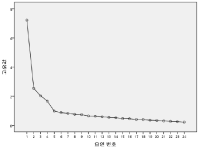
Purpose The purpose of this study was to develop the sport 5C scale of the Korean version. Methods The participants were 772 high school students from 17 to 19 who participated in sport regularly. The validation of Sport K-5C followed a three-step validation procedure through substantive stage, structural stage, and external stage. Results First, In the substantive stage, Sport K-5C consisted of 50 items with 5 factors. Second, in the structural stage, although Sport K-5C was explored as 24 items with 4 factors by EFA, but as a result of CFA, Sport K-5C was confirmed as 24 items with 5 factors. Third, the external stage provided additional validity through correlations of tests with other questionnaires which are similar concept and opposite concept, and group differentiation. Conclusions Sport K-5C is composed of 5 factors and 24 items. The factors are Caring, Character, Confidence, Competence, Connection. This scale can be used to provide an objective evaluation of positive development of youth in sport and physical education context.

PURPOSE This study investigated the associations between physical fitness and fall efficacy with thigh circumference in elderly women with osteopenia/osteoporosis. METHODS A total of 166 female participants aged 76.3±5.0 years with –1.0≥T-score of femur neck bone mineral density were voluntarily recruited from local community centers. The participants were classified as low 25%, middle 50%, and high 25% groups based on their thigh circumference. Physical fitness measurements, including strength, flexibility, aerobic endurance, and balance were measured with a standardized protocol. The Korean version of the fall efficacy scale (K-FES) was used to assess fall efficacy. Logistic regression analysis was used to estimate odd ratio (OR) of poor physical fitness and low fall efficacy according to thigh circumference levels. RESULTS In terms of physical fitness, the middle 50% group (OR=0.430, 95% CI=0.194-0.953) and high 25% group (OR=0.129, 95% CI=0.049-0.343) had significantly higher linear trend for poor physical fitness compared to the low 25% group (reference), (p<0.001). In fall efficacy, the middle 50% group (OR=0.279, 95% CI=0.119-0.656) and high 25% group (OR=0.100, 95% CI=0.036-0.275) had significantly higher linear trend for low fall efficacy compared to the low 25% group (reference) (p<0.001). CONCLUSIONS The current findings suggest that maintaining high thigh circumference via regular physical activity and diet may contribute to attenuation of decreased risk for poor physical fitness and low fall efficacy in elderly women with osteopenia/osteoporosis.